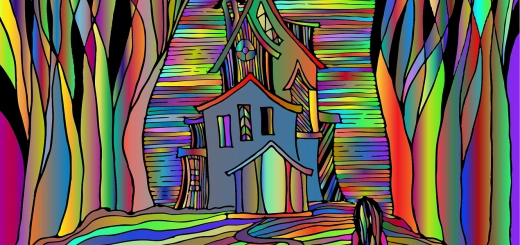The Trickster Figures in Native American Mythology

Looking for more amazing products? Check out our online store and explore our collection here! Happy shopping!
Before diving in, please note: This post is for informational purposes only. If you’d like to know more about how we approach topics, feel free to check out our friendly Disclaimer Page.
Hey there, amazing readers! 
We’re committed to delivering quality posts, and your support (even just sticking around despite the ads) means everything to us. So, bear with us, and thanks for helping us keep the good vibes rolling. Now, on to the fun stuff!
TRANSLATE BUTTON AT THE END OF THE ARTICLE
A Quick Overview
Trickster figures play a significant role in Native American mythology, representing a complex and often contradictory aspect of the human experience.
These mischievous and cunning characters are found in the folklore of various tribes across North and South America, each with their unique characteristics and stories.
While tricksters are often seen as troublemakers, they also serve as cultural heroes and bringers of wisdom and change.
In this article, we will explore the different aspects of trickster figures in Native American mythology, their common traits, their role in creation myths, their cultural significance, as well as their portrayal in contemporary culture.
Who are the Trickster Figures?
Trickster figures in Native American mythology are often portrayed as shape-shifters, thieves, liars, and rule-breakers.
They possess a mischievous and unpredictable nature, often using their cunning and wit to outsmart others.
Despite their trickery, trickster figures are not purely malevolent beings; they can also be seen as bringers of new knowledge, cultural norms, and change.
Some well-known trickster figures in Native American mythology include Coyote in Navajo and Hopi traditions, Raven in Pacific Northwest tribes, and Hare in Eastern Woodland tribes.
Common Traits of Trickster Figures
While trickster figures vary from tribe to tribe, they share some common traits that define their character.
These include:
Shape-shifting abilities: Trickster figures can take on different forms to deceive others or achieve their goals.
Trickery and deception: They often use cunning and deceit to outsmart their adversaries.
Boundary-crossing: Trickster figures blur the lines between right and wrong, challenging social norms and conventions.
Dual nature: They embody both positive and negative qualities, reflecting the complexity of human nature.
Role as culture heroes: Despite their disruptive nature, trickster figures often play a crucial role in the creation of the world and the establishment of cultural traditions.
Trickster Figures in Different Tribes
Trickster figures are prevalent in the mythology of various Native American tribes, each with their unique characteristics and stories.
Here are some examples of trickster figures in different tribes:
Coyote: A prominent trickster figure in many Plains and Southwestern tribes, Coyote is known for his cunning and mischief.
Raven: In Pacific Northwest tribes such as the Haida and Tlingit, Raven is a trickster figure associated with creation and transformation.
Nanabozho: Among Ojibwe and Menominee tribes, Nanabozho is a trickster figure who plays a key role in the creation of the world and the teaching of cultural traditions.
Hare: In Eastern Woodland tribes like the Cherokee and Iroquois, Hare is a trickster figure known for his cleverness and resourcefulness.
The Role of Trickster Figures in Creation
Trickster figures often play a central role in creation myths, where they are portrayed as key players in the emergence of the world and the establishment of cultural norms.
In many Native American traditions, tricksters are seen as shape-shifters who bring about change and transformation.
They challenge the status quo, disrupt order, and introduce new ways of thinking and being.
Through their actions, trickster figures help shape the world and the societies in which they exist, embodying the constant cycle of creation, destruction, and renewal.
Trickster Figures as Cultural Heroes
Despite their disruptive nature, trickster figures are often revered as cultural heroes who bring wisdom, knowledge, and change to their communities.
They challenge authority, question societal norms, and push boundaries, forcing people to reevaluate their beliefs and values.
By breaking the rules and defying expectations, trickster figures encourage growth, adaptation, and evolution within their cultures.
Their stories serve as cautionary tales, teaching important lessons about the consequences of hubris, greed, and arrogance.
Stories and Legends of Trickster Figures
The stories and legends of trickster figures are an integral part of Native American oral tradition, passed down through generations to teach important lessons and values.
These tales are often humorous, entertaining, and filled with clever wordplay and wit.
In many stories, trickster figures are portrayed as both heroes and villains, embodying the dual nature of humanity.
They face challenges, make mistakes, and learn valuable lessons along the way, making them relatable and human-like in their struggles and triumphs.
Trickster Figures in Contemporary Culture
Trickster figures continue to influence contemporary culture, appearing in literature, art, and popular media.
Their mischievous and cunning nature resonates with audiences, who are drawn to their complex and unpredictable behavior.
From comic books and graphic novels to television shows and films, trickster figures are often portrayed as antiheroes who challenge the status quo and question authority.
Their stories serve as a reminder of the importance of flexibility, adaptability, and creativity in navigating the complexities of the modern world.
Lessons and Morals from Trickster Tales
The stories of trickster figures in Native American mythology are filled with valuable lessons and morals for listeners and readers.
These tales often emphasize the importance of humility, respect, and cooperation in navigating the challenges of life.
Trickster figures teach us to question authority, challenge the status quo, and embrace change and transformation.
By embodying both positive and negative qualities, they remind us of the dual nature of humanity and the need for balance and harmony in our relationships with others and the natural world.
Trickster Figures in Popular Media
Trickster figures have found their way into popular media, where they are often portrayed as charismatic and enigmatic characters who defy expectations and challenge conventions.
From Loki in Norse mythology to the Joker in DC Comics, trickster figures continue to captivate audiences with their wit, charm, and unpredictability.
Their appeal lies in their ability to disrupt the norm, subvert expectations, and challenge traditional narratives.
Through their actions and antics, trickster figures encourage us to question authority, think outside the box, and embrace the unexpected.
Criticisms and Controversies Surrounding Trickster Figures
Despite their enduring popularity, trickster figures have faced criticisms and controversies for their ambiguous and sometimes problematic portrayal.
Some critics argue that trickster figures reinforce negative stereotypes and perpetuate harmful tropes about deception, chaos, and disorder.
Others point out that trickster figures can be seen as cultural appropriators who blur the lines between sacred and secular traditions.
While trickster figures are celebrated for their creativity and wit, their actions can sometimes be interpreted as harmful or disrespectful, leading to debates about their true nature and significance.
The Enduring Legacy of Trickster Figures
Trickster figures have left an indelible mark on Native American mythology, shaping the stories, beliefs, and values of countless tribes across North and South America.
Their legacy continues to inspire storytellers, artists, and scholars to explore the complexities of human nature and the eternal struggle between order and chaos.
Through their cleverness, wit, and resourcefulness, trickster figures challenge us to question our assumptions, embrace change, and seek a deeper understanding of ourselves and the world around us.
As cultural icons and symbols of transformation, trickster figures remind us of the power of storytelling to convey timeless truths and enduring wisdom.
Conclusion
Trickster figures in Native American mythology embody the complexity and contradictions of the human experience, challenging us to question authority, embrace change, and seek wisdom in unexpected places.
While they are often seen as troublemakers and rule-breakers, trickster figures also serve as cultural heroes and bringers of knowledge and transformation.
Their stories continue to resonate with audiences, inspiring creativity, adaptability, and resilience in the face of uncertainty and change.
As symbols of creativity and chaos, trickster figures remind us of the importance of embracing the unknown, challenging the status quo, and embracing the full spectrum of human potential.

The Enlightenment Journey is a remarkable collection of writings authored by a distinguished group of experts in the fields of spirituality, new age, and esoteric knowledge.
This anthology features a diverse assembly of well-experienced authors who bring their profound insights and credible perspectives to the forefront.
Each contributor possesses a wealth of knowledge and wisdom, making them authorities in their respective domains.
Together, they offer readers a transformative journey into the realms of spiritual growth, self-discovery, and esoteric enlightenment.
The Enlightenment Journey is a testament to the collective expertise of these luminaries, providing readers with a rich tapestry of ideas and information to illuminate their spiritual path.
Our Diverse Expertise
While our primary focus is on spirituality and esotericism, we are equally passionate about exploring a wide range of other topics and niches 

To ensure we provide the most accurate and valuable insights, we collaborate with trusted experts in their respective domains 
Our blog originally focused on spirituality and metaphysics, but we’ve since expanded to cover a wide range of niches. Don’t worry—we continue to publish a lot of articles on spirituality! Frequently visit our blog to explore our diverse content and stay tuned for more insightful reads.
Hey there, amazing reader! 
Check out our store here and take a peek at some of our featured products below! Thanks for being awesome!













